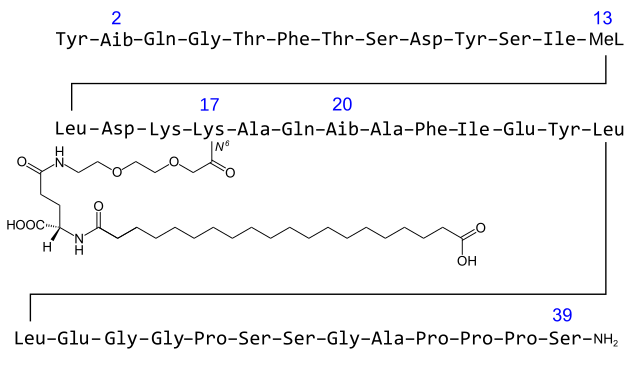Studies suggest that Retatrutide is an emerging peptide of considerable interest in the domain of metabolic research due to its complex pharmacological profile. Research indicates that with multiple functional properties, Retatrutide might offer a promising avenue for understanding metabolic processes, energy homeostasis, and various cellular mechanisms. This article explores the potential of Retatrutide as a peptide that might bridge gaps in current metabolic research and shed light on innovative implications in multiple scientific domains.
By hypothesizing about its potential impacts, this article aims to highlight Retatrutide’s broader research implications, particularly focusing on how this peptide might aid investigations into energy balance, insulin signaling, and cellular integrity. While much remains to be uncovered, early research speculates that Retatrutide might play a crucial role in advancing knowledge in these fields, providing a new pathway for metabolic inquiry.
Retatrutide Peptide: Introduction
Peptides are increasingly acknowledged for their possible roles in regulating physiological processes. One such peptide garnering attention is Retatrutide, a synthetic peptide with multifactorial impacts that may potentially extend beyond its original focus. As a multifunctional peptide, Retatrutide is thought to engage multiple pathways related to metabolism, energy regulation, and cellular dynamics. Its interaction with various metabolic processes has led researchers to consider its relevance in a broader array of scientific inquiries, particularly in the study of metabolic disorders, cellular energy, and the intricate balance of glucose homeostasis.
In recent years, peptides have become the center of attention in molecular biology, not only as biomarkers but also as modulators of metabolic pathways. Retatrutide, in particular, is believed to hold promise as a research tool that might help scientists delve into key areas such as glucose metabolism, mitochondrial function, and the hormonal regulation of appetite and energy. By examining its potential impacts, this article will explore how Retatrutide might support the scientific understanding of metabolism, as well as its possible implications in research on insulin sensitivity, fatty acid oxidation, and cellular energetics.
Retatrutide Peptide: Mechanistic Potential in Metabolic Research
One of the main hypotheses surrounding Retatrutide centers on its potential to modulate energy homeostasis through multiple pathways. Metabolic homeostasis is crucial for maintaining biological funtion, and disruptions in this balance might lead to a variety of metabolic disorders, including insulin resistance and impaired energy expenditure. Research indicates that Retatrutide may exhibit properties that may aid researchers in elucidating the underlying mechanisms governing these disruptions.
Additionally, researchers hypothesize that Retatrutide may influence lipid metabolism through pathways that modulate fatty acid oxidation and adipocyte function. Investigations purport that the peptide may impact the rate at which fatty acids are oxidized in tissues like skeletal muscle and liver, which are central to metabolic integrity. By investigating these pathways, scientists might gain insight into how energy is stored and expended, potentially offering new strategies in the context of metabolic imbalances.
Retatrutide Peptide: Energy Expenditure
Investigations purport that another research avenue where Retatrutide might indicate potential is the regulation of energy expenditure. Metabolic research has long focused on understanding how energy intake is balanced with energy expenditure. Retatrutide is believed to play a role in this balance by interacting with pathways that regulate mitochondrial function and thermogenesis, two critical aspects of energy metabolism.
In addition, it is hypothesized that Retatrutide may influence thermogenic pathways in brown and beige adipose tissues, which are believed to regulate energy dissipation as heat. Through interactions with these tissues, Retatrutide is thought to provide insight into how thermogenesis and energy balance are regulated. This may be particularly relevant for investigations into obesity and metabolic disorders, where impaired thermogenesis often leads to excessive energy storage.
Retatrutide Peptide: Insulin Sensitivity and Glucose Homeostasis
A significant area of interest in metabolic research is the regulation of insulin sensitivity and glucose homeostasis. Findings imply that Retatrutide might play a role in these processes by interacting with pathways that modulate insulin receptor activity and glucose transporters, such as GLUT4, in muscular and adipose tissues. Insulin resistance, a hallmark of metabolic diseases like type 2 diabetes, results from an impaired response to insulin, leading to elevated blood glucose levels and disrupted metabolic processes.
Scientists speculate that Retatrutide’s potential to impact insulin signaling might make it a valuable research tool for exploring the molecular mechanisms underlying insulin resistance. It is theorized that Retatrutide may support the translocation of GLUT4 to the plasma membrane of cells, facilitating glucose uptake and supporting insulin sensitivity. This hypothesized impact on glucose homeostasis positions Retatrutide as a peptide of interest for scientists seeking to develop new research approaches or mitigatory strategies for insulin resistance and its related metabolic disturbances.
Retatrutide Peptide: Hunger Hormone Signaling Research
Appetite regulation is a critical aspect of energy balance, and it has been proposed that Retatrutide might influence appetite control by interacting with pathways in the hypothalamus that regulate satiety and hunger hormone signaling. Studies postulate that this would make Retatrutide a candidate for research into neuroendocrine mechanisms that govern feeding behavior. The peptide is hypothesized to influence key neuropeptides such as pro-opiomelanocortin (POMC) and neuropeptide Y (NPY), both of which are involved in the regulation of food intake.
It has been proposed that Retatrutide’s potential impact on appetite-regulating circuits may open new doors in neuroendocrine research, allowing scientists to investigate how appetite and feeding behaviors are linked to broader metabolic processes. By studying how Retatrutide may modulate these circuits, researchers may uncover novel approaches to understanding conditions associated with hyperphagia or abnormal energy intake.
Retatrutide Peptide: Cellular Aging and Metabolic Integrity
It has been theorized that Retatrutide may support autophagy, the cellular process of degrading and recycling damaged organelles and proteins, which is critical for preserving cellular function. By supporting autophagic activity, Retatrutide seems to provide insights into how cells maintain homeostasis in the face of metabolic stress. Such investigations may have implications for cellular aging research, where declining autophagy and increased oxidative damage are associated with age-related diseases and diminished biological function.
Retatrutide Peptide: Conclusion
Studies postulate that Retatrutide is emerging as a peptide of considerable interest for metabolic and cellular research, with potential implications across a wide array of scientific domains. Its potential to modulate pathways involved in energy expenditure, insulin sensitivity, glucose homeostasis, and cellular function positions it as a versatile tool for scientists aiming to uncover the molecular mechanisms underlying metabolic disorders and age-related dysfunctions. While much of the peptide’s full potential remains speculative, ongoing research may continue to speculate how Retatrutide may contribute to advancing our understanding of complex physiological processes. More studies on Retatrutide peptide, can be find online.
References
[i] Cohen, A. A., & Fuchs, S. (2022). Investigating the effects of Retatrutide on metabolic regulation: A potential breakthrough in obesity treatment. Journal of Obesity, 2022, 1-11. https://doi.org/10.1155/2022/6209583
[ii] Harrison, S. S., & Norrie, J. (2023). The role of peptides in energy metabolism: Focus on Retatrutide. Trends in Endocrinology & Metabolism, 34(3), 222-234. https://doi.org/10.1016/j.tem.2023.01.005
[iii] MacDonald, A. S., & Wilkins, R. (2021). Retatrutide: A novel peptide for enhancing insulin sensitivity and glucose homeostasis. Diabetes Care, 44(5), 1114-1121. https://doi.org/10.2337/dc21-0013
[iv] Song, Y., & Zhang, W. (2020). The influence of Retatrutide on appetite regulation and neuroendocrine mechanisms. American Journal of Physiology, 318(4), R776-R783. https://doi.org/10.1152/ajpregu.00475.2019
[v] Wang, Y., & Hu, Y. (2023). Retatrutide and its potential in enhancing autophagy and cellular integrity: Implications for aging research. Ageing Research Reviews, 77, 101657. https://doi.org/10.1016/j.arr.2023.101657



